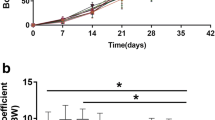Abstract
Endocrine disruptors are exogenous substances that enter the body and exhibit hormone-like action thus disrupting the homeostatic action of endogenous hormones. The most wide-spread disruptor is dichlorodiphenyltrichloroethane (DDT). The aim of this study was to investigate changes in thyroid hormone production induced by prolonged exposure to low doses of DDT. The experiment was performed on male Wistar rats treated with daily doses of DDT 1.89 ± 0.86 μg/kg and 7.77 ± 0.17 μg/kg for six and ten weeks. After six weeks there was a dose dependent increase of serum total thyroxine, total triiodthyronine, and thyroid peroxidase. Subsequently, concentration of free thyroxine decreased. These data indicate that impaired production of thyroxine by follicular thyrocytes, rather than decreased deiodinase activity and blood transport proteins is the major cause of altered thyroid status induced by DDT.
Similar content being viewed by others
References
Thomas, J., Ou, L., and All-Agely, A., Rev. Environ. Contam. Toxicol., 2008, vol. 194, pp. 55–69.
Yaglova, N.V. and Yaglov, V.V., Vestnik RAMN, 2012, no. 3, pp. 56–61.
Tebourbi, O., Driss, M., Sakle, M., and Rhouma, K., J. Environ. Sci. Health., 2006, vol. 41, pp. 167–176.
Diamanti-Kandarakis, E., Bourguignon, J.-P., Guidice, L., Hauser, R., Prins, G., Soto, A., Zoeller, T., and Gore, A., Endocr. Rev., 2009, vol. 30, pp. 293–342.
National Toxicology Program. National Toxicology Program’s report of the endocrine disruptors low dose peer review. Research Triangle Park, NC: National Institute of Environmental Health Sciences, 2001.
Vandenberg, L., Colborn, T., Hayes, T., Heindel, J., Jacobs, D., Lee, D.-H., Shioda, T., Soto, A., vom Saal, F., Welshons, W., Zoeller, T., and Myers, J., Endocr. Rev., 2012, vol. 33, pp. 378–455.
Gigienicheskie trebovaniya bezopasnosti i pishchevoi tsennosti produktov (Hygienic Requirements for Safety and Nutritional Value of Food Products), 2008, SanPin, 2.3.2.1078-01.
Orton, F., Rosivatz, E., Scholze, V., and Kortenramp, A., Environ. Health Perspect., 2011, vol. 119, pp. 794–800.
Lacroix, M. and Hontela, A., Toxicol. Appl. Pharmacol., 2003, vol. 190, pp. 197–205.
Scollon, E., Carr, J., and Cobb, C., Comp. Biochem. Physiol. C. Toxicol. Pharmacol., 2004, vol. 137, pp. 179–189.
Schell, L., Gallo, M., Denham, M., Ravenscroft, J., De Caproi, A., and Carpenter, D., Environ. Health Perspect., 2008, vol. 116, pp. 806–813.
Langer, P., Frontiers in Neuroendocrinology, 2010, vol. 31, pp. 497–518.
Meeker, J., Altshul, L., and Hauser, R., Environ. Res., 2007, vol. 104, pp. 296–304.
Dedov, I.I., Gerasimov, G.A., and Sviridenko, N.Yu., Iododefitsitnye zabolevaniya v Rossiiskoi Federatsii (epidemiologiya, diagnostika, profilaktika). Metodicheskoe posobie (Iodine Deficient Diseases in the Russian Federation (Epidemiology, Diagnostics, Prophylaxis). Methodological Textbook). Moscow, 1999.
Boas, M., Feld-Rasmussen, U., and Main, K., Mol. Cell. Endocrinol., 2012, vol. 355, pp. 240–248.
Kudo, Y. and Tamauchi, K., Toxicol. Sci., 2005, vol. 84, pp. 29–37.
Liu, C., Shi, Y., Li, H., Wang, Y., and Yang, K., Horm. Metab. Res., 2011, vol. 43, pp. 391–396.
Cody, V., Endocr. Rev., 1980, vol. 1, pp. 140–166.
Author information
Authors and Affiliations
Corresponding author
Additional information
Original Russian Text © N.V. Yaglova, V.V. Yaglov, 2015, published in Biomeditsinskaya Khimiya
Rights and permissions
About this article
Cite this article
Yaglova, N.V., Yaglov, V.V. Altered thyroid hormone production induced by long-term exposure to low doses of the endocrine disruptor dichlorodiphenyltrichloroethane. Biochem. Moscow Suppl. Ser. B 9, 339–342 (2015). https://doi.org/10.1134/S1990750815040083
Received:
Published:
Issue Date:
DOI: https://doi.org/10.1134/S1990750815040083



